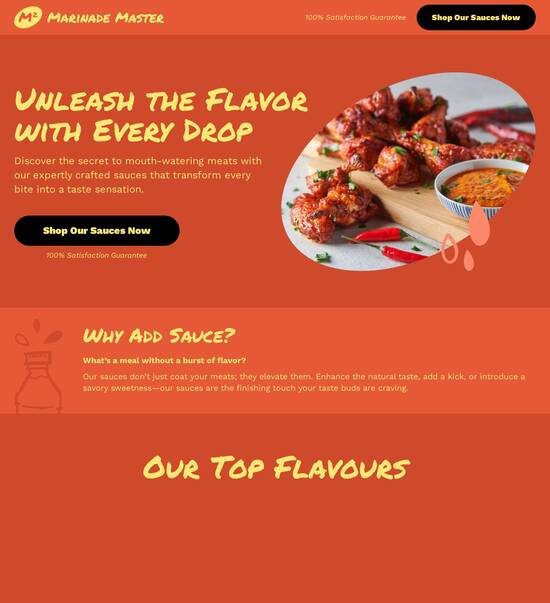
Microsite Template for Patient Navigators
Explore Similar TemplatesAbout template
Create customized landing pages for patient navigation with Instapage's flexible and easy-to-use microsite template.
Recommended templates

Easy to build without coding
With the intuitive drag-and-drop builder, anyone on your team can create high-converting pages without any knowledge of code or design. Make enhancements to your landing page with custom widgets using Javascript, HTML/CSS, or third-party scripts.

Multiple layouts for any industry and goal
Select from 500+ landing page layouts built to boost conversions across industry-specific scenarios. Customize them by adjusting fonts, adding images, and generating on-brand content with the AI assistant. Quickly scale with Instablocks® and Global Blocks that you can save, reuse, and update globally.

Loads fast and looks polished on any device
Every template is responsive, which means they present professionally on any device and load blazingly fast with our Thor Render Engine. You can also power them up with Google AMP technology to deliver an unparalleled mobile experience and drive higher conversions.

Robust analytics & experimentation
Get real-time updates and reporting across all your devices, showing the number of visitors, conversions, cost-per-visitor, and cost-per-lead. Launch AI-powered experiments, run A/B tests, and use heatmaps to analyze user behavior, then optimize your landing page to maximize conversions.







Easy to build without coding
With the intuitive drag-and-drop builder, anyone on your team can create high-converting pages without any knowledge of code or design. Make enhancements to your landing page with custom widgets using Javascript, HTML/CSS, or third-party scripts.
Multiple layouts for any industry and goal
Select from 500+ landing page layouts built to boost conversions across industry-specific scenarios. Customize them by adjusting fonts, adding images, and generating on-brand content with the AI assistant. Quickly scale with Instablocks® and Global Blocks that you can save, reuse, and update globally.
Loads fast and looks polished on any device
Every template is responsive, which means they present professionally on any device and load blazingly fast with our Thor Render Engine.
Robust analytics & experimentation
Get real-time updates and reporting across all your devices, showing the number of visitors, conversions, cost-per-visitor, and cost-per-lead. Launch AI-powered experiments, run A/B tests, and use heatmaps to analyze user behavior, then optimize your landing page to maximize conversions.
All the features you need to build lead-generating landing pages
Explore more featuresLearn how to build top-performing landing pages for any goal
FAQs
Leading the way in building high-performing landing pages





A comprehensive guide on the microsite template for patient navigators
Utilizing a microsite template for patient navigators can significantly enhance the effectiveness of patient outreach and advocacy. This guide outlines detailed steps on employing Instapage’s powerful landing page and conversion rate optimization (CRO) tools to create tailored microsites that guide patients through their healthcare journeys.
Understanding the importance of microsites in patient navigation
Microsites serve as dedicated online platforms that provide essential resources and information for patients. They can streamline communication, reduce confusion, and deliver essential updates about services and resources in a more focused manner than traditional websites. Additionally, by catering to specific needs, these microsites can greatly improve patient engagement and satisfaction.
- Enhanced patient experience: Provide tailored information that directly addresses patient needs.
- Increased engagement: Use interactive elements to keep users engaged and informed.
- Efficient communication: Offer clear pathways to essential resources, reducing navigation complexity.
Step 1: Select the right template
Choosing an appropriate microsite template is crucial for effectively communicating your mission. Instapage offers a variety of templates that are designed specifically for healthcare organizations.
- Focus groups: Gather feedback on what patients find essential to include in their navigation experience.
- Template evaluation: Review several templates that align with your branding and patient needs.
- Customization options: Ensure the chosen template allows for necessary personalization.
Step 2: Customize your content
Once you have selected a template, the next step is to customize the content to fit the unique needs of your audience. Utilizing Instapage's dynamic text replacement and personalization features can help tailor the message for diverse patient groups.
- Dynamic content: Use patient data to personalize experiences based on individual needs.
- Accessibility features: Ensure content is easily readable and understandable for all patients.
- Visual elements: Incorporate images and videos to enhance message delivery and retention.
Step 3: Optimize for conversions
After your microsite is set up, focus on optimizing it for better performance. This involves using Instapage's A/B testing features to evaluate which elements resonate most with users.
- Heatmaps: Analyze where users click most often to fine-tune placement of key resources.
- Conversion funnels: Set clear paths for users to follow based on their specific needs.
- Feedback loops: Establish mechanisms for gathering user feedback to continually improve site effectiveness.
By following these steps, your microsite can become a vital tool in navigating patient experiences effectively. The flexibility and power of Instapage make it the ideal choice for crafting impactful patient navigation resources.
Ready to take your patient navigation to the next level? Start building your customized microsite on Instapage today!
People also ask about Microsite template for Patient navigators
Microsite template for patient navigators
Understanding the role of patient navigators
Patient navigation plays a crucial role in healthcare, providing essential support for patients as they navigate the complexities of their care. It involves a systematic approach aimed at assisting patients in overcoming obstacles to healthcare access, ensuring they receive timely diagnosis and treatment. Statistics show that patients who utilize navigation services experience improved outcomes, including higher rates of attendance at appointments and better adherence to treatment protocols. These positive developments can lead to reduced healthcare costs and increased patient satisfaction.
The need for effective patient navigation has become increasingly apparent as healthcare systems strive to meet the diverse needs of patients. Navigators serve as a bridge between patients and healthcare providers, enhancing communication and ensuring that patients receive the resources necessary for optimal care. With the rise of chronic diseases and aging populations, the demand for skilled navigators continues to grow, highlighting the importance of their role in modern healthcare.
Overview of patient navigation in healthcare
Key statistics on patient outcomes and navigation
The concept of a microsite for patient navigators
A microsite is a specialized, targeted website that serves a specific purpose within the broader digital landscape. In healthcare, microsites tailored for patient navigators can provide vital information and resources, ultimately enhancing patient engagement and navigation. Unlike traditional websites which present an extensive array of information that might overwhelm users, microsites focus on specific themes, making them more effective in addressing the immediate concerns of patients.
The primary purpose of a microsite designed for patient navigation is to offer streamlined access to critical resources, tools, and support. This focused approach not only aids in addressing patient needs but also provides a platform for patient navigators to display their expertise and connect with those in their care directly. As a result, patients are more likely to find the information they need quickly and efficiently.
Definition and purpose of a microsite in healthcare
Differences between a microsite and a traditional website
Functional capabilities of a patient navigator microsite template
An effective microsite for patient navigators should include various interactive elements that enhance user engagement and provide real-time support. Features such as feedback forms and chatbots allow patients to communicate directly with their navigators, facilitating a more personalized experience. These elements not only allow patients to seek help but also provide navigators with valuable insights into the needs of the patients they serve.
Engaging and interactive microsites can also incorporate dynamic event listeners like `document.addEventListener` to track specific user interactions, such as when patients download resources or fill out feedback forms. By monitoring these events, navigators can gain a deeper understanding of patient behavior and preferences, allowing for data-driven improvements to their services. Ensuring these sites are accessible and inclusive is paramount, addressing various demographics while complying with ADA standards.
Forms for patient feedback and inquiries
Chatbots for real-time assistance
User experience design and the patient journey
Designing a microsite entails a thorough understanding of the patient’s journey, encompassing various stages from initial diagnosis to treatment and follow-up care. A well-structured microsite can offer tailored information that assists patients at each stage of their journey, improving their overall experience and engagement with healthcare services. By mapping out common patient pathways, navigators can ensure that the microsite is tailored to meet their needs effectively.
Moreover, employing intuitive design principles plays a critical role in creating a navigable experience. This involves a responsive design that ensures accessibility on a wide range of devices and a clear menu structure that minimizes confusion. Utilizing loading events like `DOMContentLoaded` enhances site performance by ensuring the site is ready for user interaction as quickly as possible, leading to higher patient satisfaction.
Understanding the stages of the patient experience
How a tailored microsite enhances navigation at each stage
Content strategies for effective communication
Effective communication is central to the success of a patient navigator microsite. Curating relevant resources that address diverse patient needs, such as articles, videos, and FAQs, ensures individuals find the information they seek without frustration. Regular updates are also essential to maintain the site's relevance and ensure that patients receive accurate information about their healthcare options.
Tailoring messaging for different patient populations is a critical strategy for achieving effective communication. By segmenting content for various demographics, navigators can enhance accessibility and provide personalized experiences. Further, using storytelling techniques to share patient success stories and testimonials can build trust and foster connections, showing prospective patients the value of navigation services.
Types of content that support patient needs (articles, videos, FAQs)
Strategies for updating information regularly
Measuring success and utilizing analytics
Measuring the success of a microsite is vital for understanding its impact on patient navigation. Key metrics such as page views, bounce rates, and user engagement levels provide insights into how well the site is functioning and whether it meets patient needs effectively. Additionally, tracking conversion rates for calls to action can help assess whether users are taking steps towards further engagement, demonstrating the microsite's effectiveness.
Utilizing analytics tools such as Google Analytics enables navigators to gather practical insights about user behavior and preferences. Techniques like A/B testing can identify the most effective content and layouts, allowing for continuous improvement of the microsite. By analyzing data, navigators can enhance their strategies and ensure that the site evolves to meet the changing needs of patients.
Page views, bounce rates, and user engagement
Conversion rates for specific calls to action
The innovations in patient navigation technology
Emerging trends in microsite development reflect advancements in technology that can significantly enhance the patient navigation experience. Integrating artificial intelligence and machine learning into microsites offers the potential for personalized experiences tailored to individual patient needs. This approach allows for smarter, more responsive content delivery, ultimately improving patient engagement and satisfaction.
Furthermore, establishing feedback loops where patients can share their experiences creates opportunities for ongoing enhancements. By collecting user feedback, microsites can continuously adapt their features to be more responsive to patient needs. This commitment to improvement ensures that the navigational resources provided remain relevant and effective, fostering a positive user experience.
Integration of AI and machine learning for personalized experiences
Future technology predictions in patient navigation
Case studies highlighting successful implementation
Examining successful patient navigator microsites reveals best practices and strategies that contribute to positive outcomes. Standout microsites in the healthcare sector effectively showcase the services of patient navigators while providing valuable resources to patients. Analyzing these examples allows for the identification of common elements that contribute to their success, such as ease of use, quality of information, and robust support features.
Statistical evidence often follows the implementation of these microsites, reflecting significant improvements in patient satisfaction and engagement metrics. By quantifying the benefits that stem from these innovative online resources, organizations can better understand the implications for their nursing and administrative staff and refine their approaches accordingly.
Brief analysis of standout microsites in the healthcare sector
Quantifying the impact of microsites on patient satisfaction and outcomes
Practical steps to create a patient navigator microsite template
Creating an effective patient navigator microsite template begins with initial planning and goal setting. Identifying the primary objectives—such as improving patient engagement or streamlining communication—helps define the site's focus. Establishing a project timeline and budget considerations is also crucial to ensure all stakeholders are aligned and resources are appropriately allocated.
Following planning, designing the user interface and user experience should prioritize visuals and functionality. Choosing appropriate colors and fonts can create an inviting atmosphere, while ensuring the design is mobile-friendly enhances accessibility. Lastly, once the microsite is launched, promoting it through targeted outreach to patients and staff, along with establishing feedback channels, ensures that it reaches its intended audience effectively.
Identifying the main objectives for the microsite
Choosing colors, fonts, and overall design aesthetics
Sustaining a long-term strategy for patient engagement
To maintain relevance in their offerings, it is essential to implement dynamic content updates on the microsite. Scheduling regular reviews of both content and functionality helps ensure that the information provided remains accurate and useful. Engaging stakeholders in this process can offer insights into evolving patient needs and highlight necessary resources that may be missing.
Building a community among patients and navigators through forums or blogs can foster shared experiences and support networks. These interactive platforms not only facilitate communication but also encourage ongoing patient engagement as they can continuously share their experiences and learn from one another. Networking opportunities for patient navigators allow for collaboration and resource sharing, ultimately enriching the overall patient experience.
Scheduling regular reviews of content and functionality
Creating forums or blogs for shared experiences
Ready to skyrocket conversions?
Supercharge your ad campaigns with high-performing landing pages
Get started














